

Particles Found to Travel Faster than Speed of Light. An Italian experiment has unveiled evidence that fundamental particles known as neutrinos can travel faster than light.
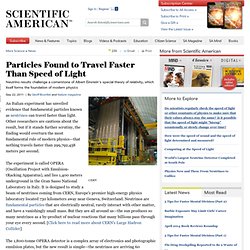
Other researchers are cautious about the result, but if it stands further scrutiny, the finding would overturn the most fundamental rule of modern physics—that nothing travels faster than 299,792,458 meters per second. The experiment is called OPERA (Oscillation Project with Emulsion-tRacking Apparatus), and lies 1,400 meters underground in the Gran Sasso National Laboratory in Italy. It is designed to study a beam of neutrinos coming from CERN, Europe's premier high-energy physics laboratory located 730 kilometers away near Geneva, Switzerland.
Neutrinos are fundamental particles that are electrically neutral, rarely interact with other matter, and have a vanishingly small mass. But they are all around us—the sun produces so many neutrinos as a by-product of nuclear reactions that many billions pass through your eye every second. Faster-than-light neutrino claim bolstered - physics-math - 23 September 2011. Read more: "Neutrinos: Complete guide to the ghostly particle" Representatives from the OPERA collaboration spoke in a seminar at CERN today, supporting their astonishing claim that neutrinos can travel faster than the speed of light.

The result is conceptually simple: neutrinos travelling from a particle accelerator at CERN in Switzerland arrived 60 nanoseconds too early at a detector in the Gran Sasso cavern in Italy. And it relies on three conceptually simple measurements, explained Dario Autiero of the Institute of Nuclear Physics in Lyon: the distance between the labs, the time the neutrinos left Switzerland, and the time they arrived in Italy. But actually measuring those times and distances to the accuracy needed to detect differences of billionths of a second (1 nanosecond = 1 billionth of a second) is no easy task. Details, details. Faster-Than-Light Neutrinos? Physics Luminaries Voice Doubts. A few dozen nanoseconds, an imperceptibly slim interval in everyday life, can make all the difference in experimental physics.
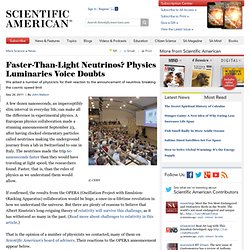
A European physics collaboration made a stunning announcement September 23, after having clocked elementary particles called neutrinos making the underground journey from a lab in Switzerland to one in Italy. The neutrinos made the trip 60 nanoseconds faster than they would have traveling at light speed, the researchers found. Faster, that is, than the rules of physics as we understand them would allow. If confirmed, the results from the OPERA (Oscillation Project with Emulsion-tRacking Apparatus) collaboration would be huge, a once-in-a-lifetime revolution in how we understand the universe.
But there are plenty of reasons to believe that Albert Einstein's long-reigning theory of relativity will survive this challenge, as it has withstood so many in the past. As an experimentalist, we are all very cautious of such extraordinary results. Leading Light: What Would Faster-Than-Light Neutrinos Mean for Physics? The stunning recent announcement of neutrinos apparently exceeding the speed of light was greeted with startled wonderment followed by widespread disbelief.
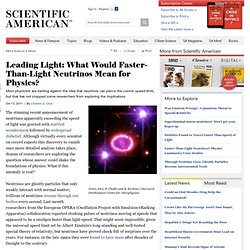
Although virtually every scientist on record expects this discovery to vanish once more detailed analysis takes place, dozens of researchers are exploring the question whose answer could shake the foundations of physics: What if this anomaly is real? Neutrinos are ghostly particles that only weakly interact with normal matter; trillions of neutrinos stream through our bodies every second. Last month researchers from the European OPERA (Oscillation Project with Emulsion-tRacking Apparatus) collaboration reported clocking pulses of neutrinos moving at speeds that appeared to be a smidgen faster than light-speed. That might seem impossible, given the universal speed limit set by Albert Einstein's long-standing and well-tested special theory of relativity, but neutrinos have proved chock full of surprises over the years. Neutrinos and multiverses: a new cosmology beckons - opinion - 28 November 2011. “THE universe is not only queerer than we suppose, but queerer than we can suppose,” as geneticist J.
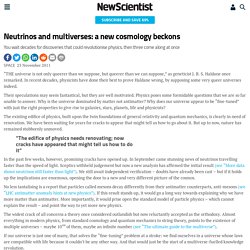
B. S. Haldane once remarked. In recent decades, physicists have done their best to prove Haldane wrong, by supposing some very queer universes indeed. Their speculations may seem fantastical, but they are well motivated. Critics Take Aim At Fast Neutrinos. A new study puts the brakes on faster-than-light neutrinos.

In September, a group at Italy’s OPERA experiment reportedly clocked neutrinos traveling the 730 kilometers from CERN in Switzerland to Italy’s underground Gran Sasso National Laboratory about 60 nanoseconds faster than light would have covered that distance in a vacuum (SN: 10/22/11, p. 18). But if this were true, most of the neutrinos would have shed energy en route, a new analysis by Boston University physicists suggests. OPERA should have detected this radiation, say the physicists, if its claims are to be believed. It didn’t. “I would be ecstatic to see some kind of new physics coming from this experiment,” says Andrew Cohen, a theoretical physicist who, with Nobel Prize–winner Sheldon Glashow, reports the new finding in an upcoming Physical Review Letters.
A similar type of energy loss has long been studied in water and other materials in which light travels slower than it does in empty space. Neutrino Parents Call Into Question Faster-than-light Results. Speedy neutrino result may be due to instrument glitch. Lisa Grossman, reporter Read more: "Neutrinos: Complete guide to the ghostly particle" Maybe it was unbelievable for a reason.
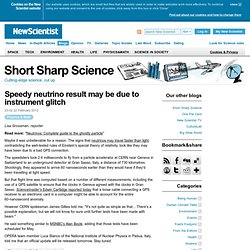
The signs that neutrinos may travel faster than light, contradicting the well-tested rules of Einstein's special theory of relativity, look like they may have been due to a bad GPS connection. The speedsters took 2.4 milliseconds to fly from a particle accelerator at CERN near Geneva in Switzerland to an underground detector at Gran Sasso, Italy, a distance of 730 kilometres. Shockingly, they appeared to arrive 60 nanoseconds earlier than they would have if they'd been travelling at light speed. Faster-than-light neutrinos dealt another blow - physics-math - 04 January 2012. Read more: "Neutrinos: Complete guide to the ghostly particle" Faster-than-light neutrinos can't catch a break.
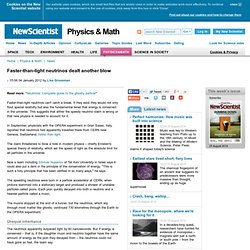
If they exist they would not only flout special relativity but also the fundamental tenet that energy is conserved in the universe. This suggests that either the speedy neutrino claim is wrong or that new physics is needed to account for it. In September, physicists with the OPERA experiment in Gran Sasso, Italy, reported that neutrinos had apparently travelled there from CERN near Geneva, Switzerland, faster than light. Neutrinos Obey The Speed Limit, After All. Want to stay on top of all the space news?
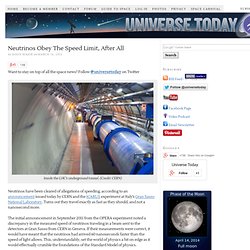
Follow @universetoday on Twitter Inside the LHC's underground tunnel. (Credit: CERN) Neutrinos have been cleared of allegations of speeding, according to an announcement issued today by CERN and the ICARUS experiment at Italy’s Gran Sasso National Laboratory. Turns out they travel exactly as fast as they should, and not a nanosecond more. Loose Cable Blamed For Speedy Neutrinos.
Astrophile: The relativity-testing supernova next door - space - 24 February 2012. Astrophile is our weekly column on curious cosmic objects, from the solar system to the far reaches of the multiverse Object type: Exploding starLocation: 160,000 light years from Earth, in the Large Magellanic Cloud "Once in a lifetime" barely begins to describe it – astronomers had literally been waiting centuries for such a spectacle.

Particles break light-speed limit. Neutrinos: Everything you need to know - physics-math - 27 September 2011. Read more: "Neutrinos: Complete guide to the ghostly particle" "…We don't allow faster-than-light neutrinos in here," says the barman. A neutrino walks into a bar…" As reports spread of subatomic particles moving faster than light and potentially travelling through time, such gags were born.
But apparently super-hasty motion is not the only strange thing about neutrinos. What exactly are they? With a neutral charge and nearly zero mass, neutrinos are the shadiest of particles, rarely interacting with ordinary matter and slipping through our bodies, buildings and the Earth at a rate of trillions per second. First predicted in 1930 by Wolfgang Pauli, who won a Nobel prize for this work in 1945, they are produced in various nuclear reactions: fusion, which powers the sun; fission, harnessed by humans to make weapons and energy; and during natural radioactive decay inside the Earth. If they are so stealthy, how do we know they are there at all? Where are these experiments found?
Anything else? WMAP Big Bang Concepts. The Big Bang model of cosmology rests on two key ideas that date back to the early 20th century: General Relativity and the Cosmological Principle. By assuming that the matter in the universe is distributed uniformly on the largest scales, one can use General Relativity to compute the corresponding gravitational effects of that matter. Since gravity is a property of space-time in General Relativity, this is equivalent to computing the dynamics of space-time itself. The story unfolds as follows: Given the assumption that the matter in the universe is homogeneous and isotropic (The Cosmological Principle) it can be shown that the corresponding distortion of space-time (due to the gravitational effects of this matter) can only have one of three forms, as shown schematically in the picture at left.
Before we discuss which of these three pictures describe our universe (if any) we must make a few disclaimers: Matter plays a central role in cosmology. Let’s celebrate the search for the ‘God particle’ It is amazing how, no matter what people’s background, the quest to discover the basic laws of nature that underlie the very fabric of the universe has the capacity to engage the imagination.
And what could be more abstract and esoteric than the search for the Higgs boson? The boson is a particle predicted by Peter Higgs in 1964 in an attempt to explain the inability of the standard model of particle physics to explain a fundamental concept: mass. His explanation for mass predicts a universal forcefield, through which everything must travel, that acts a bit like treacle. Hunt for Higgs Particle Enters Endgame.
By Geoff Brumfiel of Nature magazine Bill Murray is a man with secrets. Along with a handful of other scientists based at CERN, Europe's particle-physics facility near Geneva, Switzerland, Murray is one of the few researchers with access to the latest data on the Higgs boson -- the most sought-after particle in physics. Looking at his laptop, he traces a thin black line that wiggles across a shaded area at the centre of a graph. This is the fruit of his summer's labours. "It's interesting, actually, looking at this again," he muses. Despite Murray's coyness, there are few places left for the Higgs to hide. Where’s My Higgs? LHC Physicist Joe Lykken Speaks.
On December 13, CERN will release the results of a new data analysis in the search for the Higgs boson. at the LHC. As I was reporting my article, which appeared today, on December 7 I spoke on the phone with Joe Lykken, a Fermilab staff theoretical physicist. Lykken is a member of the CMS collaboration, one of the two largest experiments at the LHC (the other one being ATLAS). The following is a lightly edited, partial transcript of that conversation. Do you have high expectations for next week? It will be an interesting meeting. What Higgs result means for dark matter conspiracy - 21 December 2011. Read more: Click here to read a longer version of this story RECENT hints of a featherweight Higgs boson don't just take us nearer to a complete standard model of physics.
What if there is no Higgs boson? - physics-math - 09 December 2011. Read full article Continue reading page |1|2 This could be it. The Large Hadron Collider finally has enough data to explore every nook and cranny where the elusive Higgs boson could be hiding. LHC physicists will announce the results of their latest hunt on Tuesday at CERN in Switzerland. Has the Higgs Been Discovered? Physicists Gear Up for Watershed Announcement. LHC sees hint of lightweight Higgs boson - physics-math - 13 December 2011. Read full article Continue reading page |1|2. Hunting the Higgs - David Kaiser.
Exit from comment view mode. Click to hide this space CAMBRIDGE – Fifty years ago, particle physicists faced an unexpected challenge. Their best mathematical models could account for some of the natural forces that explain the structure and behavior of matter at a fundamental level, such as electromagnetism and the weak nuclear force responsible for radioactive decay. Scientists to unveil proof of ‘God particle’ Click image to see more photos. Higgs-like Particle Discovered at CERN. Higgs Found. Finally, physics’s zoo of subatomic particles is full. Scientists have almost certainly snared the Higgs boson, the last particle waiting to be roped into the fold.
Higgs fever: Your guide to the most-wanted particle - physics-math - 02 July 2012. Read full article. The missing piece. Peter Higgs tells James Elwes that without the Higgs boson, our physical model of the universe does not work. Higgs Boson Might Yield Origins of Universe But Questions Remain. Higgs result means elegant universe is back in vogue - physics-math - 06 January 2012. What the latest LHC revelations say about the Higgs - physics-math - 09 February 2012.
Conflicting Higgs results muddy particle hunt - physics-math - 07 March 2012. Higgs hunt enters endgame. Higgs Boson Signal Gains Strength. Higgs boson: Excitement builds over 'glimpses' at LHC. Does the “Goddamn” Higgs Particle Portend the End of Physics? LHC boosts energy to snag Higgs – and superpartners - physics-math - 13 February 2012. LHC smashes particle collision record. Have we summoned the mysterious Majorana fermion? - physics-math - 15 March 2012. Long-sought Particles Possibly Glimpsed. Quantum "Graviton" Particles May Resemble Ordinary Particles of Force. What’s In a Femtosecond of Laser Light? A Map of Electron Energy. Supercomputer probes famous but messy particle split - physics-math - 13 April 2012. The Particle Adventure. Happy Birthday, Electron. Higgsteria rising as trouble brews for standard model - physics-math - 19 June 2012. New "Beauty Baryon" Particle Discovered at Large Hadron Collider.
LHC gets first glimpse of excited baryon - physics-math - 01 May 2012. Lazy photon among the missing in exotic LHC roll call - physics-math - 31 January 2012. Quest for Quirky Quantum Particles May Have Struck Gold. Peaceable matter-antimatter pairs glimpsed in the lab - physics-math - 29 February 2012. Flavor of the Ray: Neutrino Measurement May Help Solve Mystery of Matter's Domination over Antimatter.
Neutrinos could help explain missing antimatter - physics-math - 09 March 2012. First ever measurement on atom of pure antimatter. Antimatter: The Production Problem. Protons On The Move Find Novel Molecular Route. The Vega Science Trust - Richard Feynman - Science Videos. Hunt For Cosmic Ray Source Falls Short. Cosmic Rays: They Aren’t What We Thought They Were. Proposed Type Of Solar Neutrino Spotted. Neutrinos don't outpace light, but they do shape-shift - physics-math - 08 June 2012.